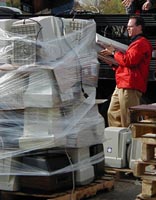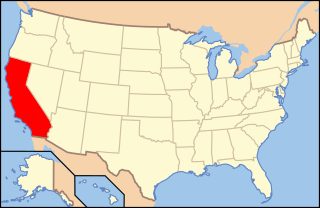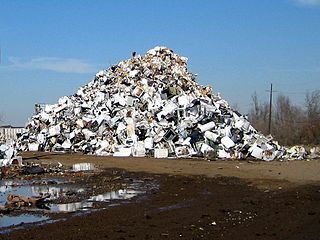
Mining is the extraction of valuable minerals or other geological materials from the Earth, usually from an ore body, lode, vein, seam, reef or placer deposit. These deposits form a mineralized package that is of economic interest to the miner.

Recycling is the process of converting waste materials into new materials and objects. It is an alternative to "conventional" waste disposal that can save material and help lower greenhouse gas emissions. Recycling can prevent the waste of potentially useful materials and reduce the consumption of fresh raw materials, thereby reducing: energy usage, air pollution, and water pollution.

A rare-earth element (REE) or rare-earth metal (REM), as defined by the International Union of Pure and Applied Chemistry, is one of a set of seventeen chemical elements in the periodic table, specifically the fifteen lanthanides, as well as scandium and yttrium. Scandium and yttrium are considered rare-earth elements because they tend to occur in the same ore deposits as the lanthanides and exhibit similar chemical properties, but have different electronic and magnetic properties. Rarely, a broader definition that includes actinides may be used, since the actinides share some mineralogical, chemical, and physical characteristics.

Waste management are the activities and actions required to manage waste from its inception to its final disposal. This includes the collection, transport, treatment and disposal of waste, together with monitoring and regulation of the waste management process.

The Waste Electrical and Electronic Equipment Directive is the European Community Directive 2012/19/EU on waste electrical and electronic equipment (WEEE) which, together with the RoHS Directive 2011/65/EU, became European Law in February 2003. The WEEE Directive set collection, recycling and recovery targets for all types of electrical goods, with a minimum rate of 4 kilograms per head of population per annum recovered for recycling by 2009. The RoHS Directive set restrictions upon European manufacturers as to the material content of new electronic equipment placed on the market.

Scrap consists of recyclable materials left over from product manufacturing and consumption, such as parts of vehicles, building supplies, and surplus materials. Unlike waste, scrap has monetary value, especially recovered metals, and non-metallic materials are also recovered for recycling.

Computer recycling, electronic recycling or e-waste recycling is the disassembly and separation of components and raw materials of waste electronics. Although the procedures of re-use, donation and repair are not strictly recycling, these are other common sustainable ways to dispose of IT waste.
In metallurgy, a non-ferrous metal is a metal, including alloys, that does not contain iron (ferrite) in appreciable amounts.

Electronic waste or e-waste describes discarded electrical or electronic devices. Used electronics which are destined for refurbishment, reuse, resale, salvage recycling through material recovery, or disposal are also considered e-waste. Informal processing of e-waste in developing countries can lead to adverse human health effects and environmental pollution.
Landfill mining and reclamation (LFMR) is a process which excavates and processes solid wastes which have previously been landfilled. The process aims to reduce the amount of landfill mass encapsulated within the closed landfill and/or temporarily remove hazardous material to allow protective measures to be taken before the landfill mass is replaced. In the process, mining recovers valuable recyclable materials, a combustible fraction, soil, and landfill space. The aeration of the landfill soil is a secondary benefit with regard to the landfill's future use. The combustible fraction is useful for the generation of power. The overall appearance of the landfill mining procedure is a sequence of processing machines laid out in a functional conveyor system. The operating principle is to excavate, sieve and sort the landfill material.

Battery recycling is a recycling activity that aims to reduce the number of batteries being disposed as municipal solid waste. Batteries contain a number of heavy metals and toxic chemicals and disposing of them by the same process as regular trash has raised concerns over soil contamination and water pollution.

The environment of California describes results of human habitation of the State of California.

Waste are unwanted or unusable materials. Waste is any substance which is discarded after primary use, or is worthless, defective and of no use. A by-product by contrast is a joint product of relatively minor economic value. A waste product may become a by-product, joint product or resource through an invention that raises a waste product's value above zero.

Electronic waste or e-waste in the United States refers to electronic products that have reached the end of their operable lives, and the United States is beginning to address its waste problems with regulations at a state and federal level. Used electronics are the quickest-growing source of waste and can have serious health impacts. The United States is the world leader in producing the most e-waste, followed closely by China; both countries domestically recycle and export e-waste. Only recently has the United States begun to make an effort to start regulating where e-waste goes and how it is disposed of.

Electronic waste is a significant part of today's global, post-consumer waste stream. Efforts are being made to recycle and reduce this waste.
This is an index of recycling topics.

As a nation, Americans generate more waste than any other nation in the world, officially with 4.4 pounds (2.0 kg) of municipal solid waste (MSW) per person per day, with another study estimating 7.1 pounds (3.2 kg) per capita per day. Fifty five percent of this waste is contributed as residential garbage, while the remaining forty five percent of waste in the U.S.'s ‘waste stream' comes from manufacturing, retailing, and commercial trade in the U.S. economy. Based on proprietary data released to the public, Nevada was named America's "Most Wasteful State" for the years 2005-2010; where each resident threw away over 14 pounds of non-recycled, unreused items, often ending up into landfills and incinerators per day, eight pounds over the national state daily throwaway average. "Wasteful" states Michigan, New Mexico, Wisconsin and Oregon as well as Washington also dominated the list's 5-year period.
Resource recovery is using wastes as an input material to create valuable products as new outputs. The aim is to reduce the amount of waste generated, therefore reducing the need for landfill space and also extracting maximum value from waste. Resource recovery delays the need to use raw materials in the manufacturing process. Materials found in municipal solid waste can be used to make new products. Plastic, paper, aluminium, glass and metal are examples of where value can be found in waste.

The ISASMELT process is an energy-efficient smelting process that was jointly developed from the 1970s to the 1990s by Mount Isa Mines Limited and the Australian government’s Commonwealth Scientific and Industrial Research Organisation ("CSIRO"). It has relatively low capital and operating costs for a smelting process.

Appliance recycling is the process of dismantling waste home appliances and scrapping their parts for reuse. Recycling appliances for their original or other purposes, involves disassembly, removal of hazardous components and destruction of the end-of-life equipment to recover materials, generally by shredding, sorting and grading. The rate at which appliances are discarded has increased with technological advancement. This correlation directly leads to the question of appropriate disposal. The main types of appliances that are recycled are televisions, refrigerators, air conditioners, washing machines, and computers. When appliances are recycled, they can be looked upon as valuable resources. If disposed of improperly, appliances can become environmentally harmful and poison ecosystems.

















